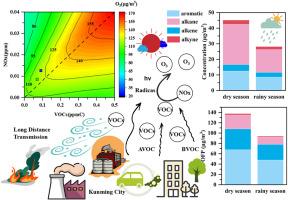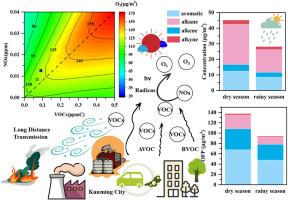A new insight of volatile organic compounds measurement in Kunming City, Southwest China: season variation, chemical characteristics, and ozone formation sensitivity
IF 7.3
2区 环境科学与生态学
Q1 ENVIRONMENTAL SCIENCES
引用次数: 0
Abstract
As a typical border city in Southwest China, Kunming exhibited different characteristics of volatile organic compounds (VOCs) and ozone (O3) in dry and rainy seasons, influenced by anthropogenic activities, meteorological conditions, and regional transport. The concentration of VOCs during the dry season (45.2 ± 16.8 μg/m3) was significantly higher than that in the rainy season (28.2 ± 14.3 μg/m3). The anthropogenic volatile organic compounds (AVOC) were predominantly composed of alkanes and aromatics, with motor vehicle emissions being the primary source (39.7 %–42.5 %). High temperatures (above 20 °C) and low relative humidity (below 70 %) facilitated O3 formation. During the dry season, air masses from the southwest of Yunnan accounted for 81.7 % (with 32.3 % originating from Myanmar), and the concentration contributions of VOCs and O3 in this direction exceeded 30 μg/m3 and 120 μg/m3, respectively. In contrast, air masses during the rainy season originated mainly from local and southern Yunnan (87.6 %). The ozone formation potential (OFP) was recorded at 137.7 μg/m3 during the dry season and 93.9 μg/m3 in the rainy season, with the rate of loss of hydroxyl radicals (LOH) at 5.0/s and 4.5/s, respectively. Furthermore, O3 formation in Kunming was limited by VOCs, and reducing O3 emissions was more effective when accompanied by a reduction in VOCs rather than NOx. When VOCs reductions exceed 25 %, the reduction ratio of NOx must be increased concurrently. This study provides significant guidance for controlling air pollution and ozone generation in Kunming and other border cities in Southwest China.


昆明市挥发性有机物测量的新视角:季节变化、化学特征和臭氧形成敏感性
昆明作为西南地区典型的边陲城市,受人为活动、气象条件和区域交通等因素的影响,其挥发性有机物(VOCs)和臭氧(O3)在旱季和雨季表现出不同的特征。旱季VOCs浓度(45.2±16.8 μg/m3)显著高于雨季(28.2±14.3 μg/m3)。人为挥发性有机化合物(AVOC)主要由烷烃和芳烃组成,机动车排放是主要来源(39.7% ~ 42.5%)。高温(高于20°C)和低相对湿度(低于70%)有利于O3的形成。旱季来自滇西南的气团占81.7%,其中来自缅甸的气团占32.3%,该方向VOCs和O3的浓度贡献分别超过30 μg/m3和120 μg/m3。雨季气团主要来自滇南地区(87.6%)。旱季臭氧形成势(OFP)为137.7 μg/m3,雨季臭氧形成势(OFP)为93.9 μg/m3,羟基自由基损失速率(LOH)分别为5.0/s和4.5/s。此外,昆明地区O3的形成受到VOCs的限制,减少O3排放的同时减少VOCs比减少NOx更有效。当VOCs减排超过25%时,必须同时提高NOx的减排比例。该研究对昆明等西南边境城市大气污染和臭氧生成的控制具有重要的指导意义。
本文章由计算机程序翻译,如有差异,请以英文原文为准。
求助全文
约1分钟内获得全文
求助全文
来源期刊

Environmental Pollution
环境科学-环境科学
CiteScore
16.00
自引率
6.70%
发文量
2082
审稿时长
2.9 months
期刊介绍:
Environmental Pollution is an international peer-reviewed journal that publishes high-quality research papers and review articles covering all aspects of environmental pollution and its impacts on ecosystems and human health.
Subject areas include, but are not limited to:
• Sources and occurrences of pollutants that are clearly defined and measured in environmental compartments, food and food-related items, and human bodies;
• Interlinks between contaminant exposure and biological, ecological, and human health effects, including those of climate change;
• Contaminants of emerging concerns (including but not limited to antibiotic resistant microorganisms or genes, microplastics/nanoplastics, electronic wastes, light, and noise) and/or their biological, ecological, or human health effects;
• Laboratory and field studies on the remediation/mitigation of environmental pollution via new techniques and with clear links to biological, ecological, or human health effects;
• Modeling of pollution processes, patterns, or trends that is of clear environmental and/or human health interest;
• New techniques that measure and examine environmental occurrences, transport, behavior, and effects of pollutants within the environment or the laboratory, provided that they can be clearly used to address problems within regional or global environmental compartments.
 求助内容:
求助内容: 应助结果提醒方式:
应助结果提醒方式:


